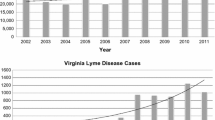Abstract
Lyme disease is the most frequently reported vector borne illness in the United States, and incidences are increasing steadily year after year. This study explores the influence of landscape (e.g., land use pattern and landscape fragmentation) and climatic factors (e.g., temperature and precipitation) at a regional scale on Lyme disease incidence. The study area includes thirteen states in the Northeastern United States. Lyme disease incidence at county level for the period of 2002–2006 was linked with several key landscape and climatic variables in a negative binomial regression model. Results show that Lyme disease incidence has a relatively clear connection with regional landscape fragmentation and temperature. For example, more fragmentation between forests and residential areas results in higher local Lyme disease incidence. This study also indicates that, for the same landscape, some landscape variables derived at a particular scale show a clearer connection to Lyme disease than do others. In general, the study sheds more light on connections between Lyme disease incidence and climate and landscape patterns at the regional scale. Integrating findings of this regional study with studies at a local scale will further refine understanding of the pattern of Lyme disease as well as increase our ability to predict, prevent, and respond to disease.

Similar content being viewed by others
References
Allan, BF, Keesing F, Ostfeld RS (2003) Effect of Forest Fragmentation on Lyme Disease Risk. Conservation Biology 17:267-272
Bown KJ, Begon M, Bennett M, Woldehiwet Z, Ogden NH (2003) Seasonal Dynamics of Anaplasma phagocytophila in a Rodent-Tick (Ixodes trianguliceps) System, United Kingdom. Emerging Infectious Diseases 9:63–70
Brownstein, JS, Holford TR, Durland F (2003) A Climate-Based Model Predicts the Spatial Distribution of the Lyme Disease Vector Ixodes scapularis in the United States. Environmental Health Perspectives 111:1152-1157
Brownstein, JS, Skelly DK, Holford TR, Durland F (2005) Forest Fragmentation Predicts Local Scale Heterogeneity of Lyme Disease Risk. Oecologia 146:469-475
CDC (2012) Geographic distribution, CDC. http://www.cdc.gov/ticks/geographic_distribution.html#western-blacklegged. Accessed 14 January 2013.
Das A, Lele SR, Glass GE, Shields G, Patz J (2002) Modelling a discrete spatial response using generalized linear mixed models: application to Lyme disease vectors. International Journal of Geographical Information Science 16:151-166
Diuk-Wasser MA, Gatewood AG, Cortinas MR, Yaremych-Hamer S, Tsao J, Kitron U, et al. (2006) Spatiotemporal patterns of host-seeking Ixodes scapularis nymphs (Acari:Ixodidae) in the United States. Journal of medical entomology 43:166-176
ESRI (2011) ArcGIS Desktop: Release 10. Redlands, CA: Environmental Systems Research Institute.
Frank D, Fish D, Moy F (1998) Landscape features associated with Lyme disease risk in a suburban residential environment. Landscape Ecology 13:27-36.
Gavanakov S, White DJ, Caraco T, Lapenis A., Robinson GR, Szymanski BK, et al. (2001) Lyme disease in New York state: Spatial pattern at a regional scale. American Journal of Tropical Medicine and Hygiene 65:538-545
Glass GE, Schwartz BS, Morgan JM, Johnson DT, Noy PM, Israel E (1995) Environmental risk factors for Lyme disease identified with geographic information systems. American Journal of Public Health 85:944-948
Guerra M, Walker E, Jones C, Paskewitz S, Cortinas MR, Stancil A, et al. (2002) Predicting the Risk of Lyme Disease: Habitat Suitability for Ixodes scapularis in the North Central United States., Emerging Infectious Diseases 8:289-297
Hilbe J (2007) Negative binomial regression. Cambridge : Cambridge University Press.
Homer C, Dewitz J, Fry J, Coan M, Hossain N, Larson C, Herold N, McKerrow A, VanDriel JN, Wickham J (2007) Completion of the 2001 National Land Cover Database for the Conterminous United States. Photogrammetric Engineering and Remote Sensing 73(4): 337-341
IBM Corp (2011) IBM SPSS Statistics for Windows, Version 20.0, Released 2011. Armonk, NY: IBM Corp.
Jackson LE, Hilborn ED, Thomas JC (2006) Towards landscape design guidelines for reducing Lyme disease risk. International Journal of Epidemiology 35:315-322
Jones CJ, Kitron UD (2000) Populations of Ixodes scapularis (Acari: Ixodidae) are modulated by drought at a Lyme disease focus in Illinois. Journal of Medical Entomology 37:408–415
Khatchikian CE, Prusinski M, Stone M, Backenson PB, Wang I, Levy MZ, et al. (2012) Geographical and environmental factors driving the increase in the Lyme disease vector Ixodes scapularis. Ecosphere 3:1-18
Killilea ME, Lane RS, Briggs CJ, Ostfeld RS (2008) Spatial Dynamics of Lyme Disease: A Review. EcoHealth 5:1-29
McCabe GJ, Bunnell JE (2004) Precipitation and the occurrence of Lyme disease in the northeastern United States. Vector Borne and Zoonotic Diseases 4: 143-148.
McGarigal K, Cushman SA, Ene E (2012) FRAGSTATS v4: spatial pattern analysis program for categorical and continuous maps. Computer software program, University of Massachusetts, Amherst. http://www.umass.edu/landeco/research/fragstats/fragstats.html.
Orloski KA, Hayes EB, Campbell GL, Dennis DT (2000) Surveillance for Lyme disease—United States, 1992–1998. Morbidity and Mortality Weekly Report 49:1–11
Ostfeld RS, Canham CD, Oggenfuss K, Winchcombe RJ, Keesing F (2006) Climate, Deer, Rodents, and Acorns as Determinants of Variation in Lyme-Disease Risk. PLoS Biology 4:, p. 1058-1068.
Schauber EM, Ostfeld RS, Evans Jr. AS (2005) What is the best predictor of annual Lyme Disease incidence: Weather, Mice, or Acorns? Ecological Applications. 15:575–586
Subak S (2003) Effects of Climate on Variability in Lyme Disease Incidence in the Northeastern United States. American Journal of Epidemiology 157:531-538
URI TERC (2013) Tick habitat, University of Rhode Island Tick Encounter Resource Center. http://www.tickencounter.org/faq/tick_habitat. Accessed 12 January 2013.
Waller, LA., Goodwin BJ, Wilson ML, Ostfeld RS, Marshall SL, Hayes EBet al. (2007) . “Spatio-temporal patterns in county-level incidence and reporting of Lyme disease in the northeastern United States, 1990–2000.” Environmental and Ecological Statistics 14: (1): 83-100.
Acknowledgements
The authors would like to extend their immense gratitude to the Emory University SIRE program for the grant that made it possible to cover the cost of the technological materials needed for this research.
Author information
Authors and Affiliations
Corresponding author
Rights and permissions
About this article
Cite this article
Tran, P.M., Waller, L. Effects of Landscape Fragmentation and Climate on Lyme Disease Incidence in the Northeastern United States. EcoHealth 10, 394–404 (2013). https://doi.org/10.1007/s10393-013-0890-y
Received:
Revised:
Accepted:
Published:
Issue Date:
DOI: https://doi.org/10.1007/s10393-013-0890-y




